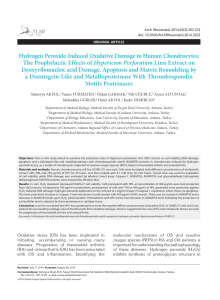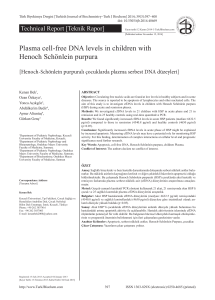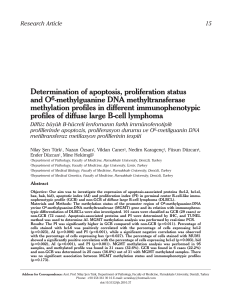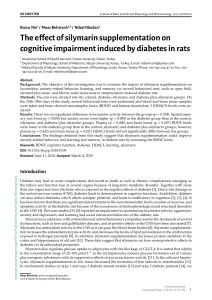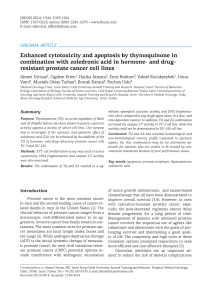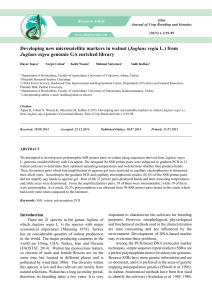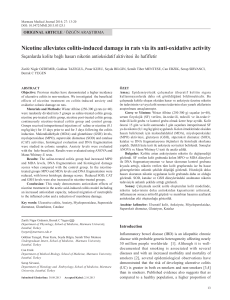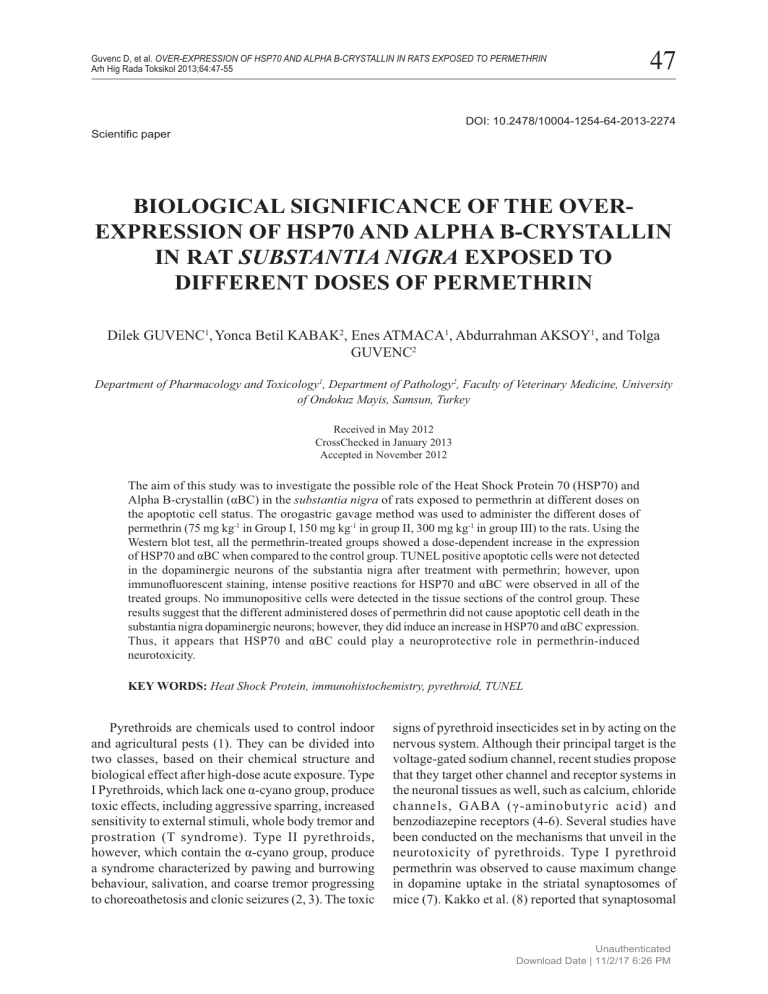
Guvenc D, et al. OVER-EXPRESSION OF HSP70 AND ALPHA B-CRYSTALLIN IN RATS EXPOSED TO PERMETHRIN
Arh Hig Rada Toksikol 2013;64:47-55
47
DOI: 10.2478/10004-1254-64-2013-2274
Scientific paper
BIOLOGICAL SIGNIFICANCE OF THE OVEREXPRESSION OF HSP70 AND ALPHA B-CRYSTALLIN
IN RAT SUBSTANTIA NIGRA EXPOSED TO
DIFFERENT DOSES OF PERMETHRIN
Dilek GUVENC1, Yonca Betil KABAK2, Enes ATMACA1, Abdurrahman AKSOY1, and Tolga
GUVENC2
Department of Pharmacology and Toxicology1, Department of Pathology2, Faculty of Veterinary Medicine, University
of Ondokuz Mayis, Samsun, Turkey
Received in May 2012
CrossChecked in January 2013
Accepted in November 2012
The aim of this study was to investigate the possible role of the Heat Shock Protein 70 (HSP70) and
Alpha B-crystallin (αBC) in the substantia nigra of rats exposed to permethrin at different doses on
the apoptotic cell status. The orogastric gavage method was used to administer the different doses of
permethrin (75 mg kg-1 in Group I, 150 mg kg-1 in group II, 300 mg kg-1 in group III) to the rats. Using the
Western blot test, all the permethrin-treated groups showed a dose-dependent increase in the expression
of HSP70 and αBC when compared to the control group. TUNEL positive apoptotic cells were not detected
in the dopaminergic neurons of the substantia nigra after treatment with permethrin; however, upon
immunofluorescent staining, intense positive reactions for HSP70 and αBC were observed in all of the
treated groups. No immunopositive cells were detected in the tissue sections of the control group. These
results suggest that the different administered doses of permethrin did not cause apoptotic cell death in the
substantia nigra dopaminergic neurons; however, they did induce an increase in HSP70 and αBC expression.
Thus, it appears that HSP70 and αBC could play a neuroprotective role in permethrin-induced
neurotoxicity.
KEY WORDS: Heat Shock Protein, immunohistochemistry, pyrethroid, TUNEL
Pyrethroids are chemicals used to control indoor
and agricultural pests (1). They can be divided into
two classes, based on their chemical structure and
biological effect after high-dose acute exposure. Type
I Pyrethroids, which lack one α-cyano group, produce
toxic effects, including aggressive sparring, increased
sensitivity to external stimuli, whole body tremor and
prostration (T syndrome). Type II pyrethroids,
however, which contain the α-cyano group, produce
a syndrome characterized by pawing and burrowing
behaviour, salivation, and coarse tremor progressing
to choreoathetosis and clonic seizures (2, 3). The toxic
signs of pyrethroid insecticides set in by acting on the
nervous system. Although their principal target is the
voltage-gated sodium channel, recent studies propose
that they target other channel and receptor systems in
the neuronal tissues as well, such as calcium, chloride
channels, GABA (γ-aminobutyric acid) and
benzodiazepine receptors (4-6). Several studies have
been conducted on the mechanisms that unveil in the
neurotoxicity of pyrethroids. Type I pyrethroid
permethrin was observed to cause maximum change
in dopamine uptake in the striatal synaptosomes of
mice (7). Kakko et al. (8) reported that synaptosomal
Unauthenticated
Download Date | 11/2/17 6:26 PM
48
Guvenc D, et al. OVER-EXPRESSION OF HSP70 AND ALPHA B-CRYSTALLIN IN RATS EXPOSED TO PERMETHRIN
Arh Hig Rada Toksikol 2013;64:47-55
membrane-bound ATPases mediate the neurotoxic
effects of the pyrethroids. While low-dose permethrin
(3 mg kg-1) significantly decreases the dopamine
transporter immunoreactive protein, high-dose
permethrin (200 mg kg-1) significantly increases the
glial fibrillary acidic protein in the striatum of
C57BL/6 mice (9). The expression of tyrosine
hydroxylase (TH) and the dopamine transporter
protein (DAT) in the striatal dopaminergic terminals
of mice did not change when subjected to long-term
(3 months) and low doses (between 0.8 mg kg-1 and
1.5 mg kg-1) of permethrin (10).
Prokaryotic and eukaryotic cells both contain Heat
Shock Proteins (HSPs). A wide variety of stress factors
such as heavy metals, pesticides, solvents, sodium
arsenite, nitric oxide, glucose and amino acid
analogues, ischemia, microbial infections and
antibiotics can induce HSPs (11, 12). HSPs have a
molecular-chaperone activity involving several
aspects of protein synthesis including the prevention
of premature protein folding, restoration of denaturing
proteins, transportation and translocalization processes
(13, 14). Recently, HSPs have also been found to
regulate apoptosis by acting on different stages of
programmed cell death machinery (15). Upregulation
and overexpression of HSPs in the nervous system is
associated with their neuroprotective role (16-18). The
neuroprotective effects of HSPs take place by antiapoptotic and chaperoning activities (18). They can
be classified into five major categories based on their
molecular weight, amino acid sequence homologies
and functions. They include the HSP100 family,
HSP90 family, HSP70 family, HSP60 family and the
small HSP family (12).
The HSP70 family comprises two major members,
viz., HSP70, an inducible form, and Hsc70, the heat
shock cognate protein, a constitutively expressed
form. HSP70 is never expressed in the brain under
non-stressed conditions (19). Therefore, due to the
fact that inducible HSP70 cannot be detected under
normal conditions, it serves as a useful sensitive
marker for neuronal injury (20). Several studies have
indicated the expression of HSP70 to be a response to
various neurotoxic stimuli, including hyperthermia,
cerebral and focal ischemia, seizures, excitotoxicity,
subarachnoid haemorrhage and spinal cord injury (20,
21).
Primarily defined as a major component of the eye
lens, αBC belongs to the family of small HSPs. It is
also found in non-lenticular tissues such as the heart,
skeletal muscle, skin, oesophagus, kidney, placenta,
peripheral nerves and nervous system (22).
Interestingly, αBC expression has also been detected
in heat shock, anticancer drugs, radiation and oxidative
stress (23). In a normal central nervous system, αBC
is present in glial cells, particularly in astrocytes and
oligodendrocytes, although not in the neurons (24).
The neuronal expression of αBC has been investigated
in Alexander’s disease, Alzheimer’s disease, Pick’s
disease, Creutzfeldt-Jakob disease, multiple sclerosis
(25), astrocytoma, glioblastoma multiforme and
oligodendroglioma (26). Thus, αBC is considered to
be a good molecular marker for neurodegenerative
disorders and brain tumours (25, 27).
Relatively little information is available on the
possible dose-related toxicity of permethrin, despite its
wide application in practice. Also, not much is known
on permethrin-induced apoptotic cell death in the
substantia nigra. Therefore, the aim of this study is to
investigate the apoptosis in the substantia nigra of rats
exposed to different doses of permethrin, as well as the
interaction of permethrin with HSP70 and αBC.
MATERIAL AND METHODS
Animals and Treatments
Approval for the experimental protocol involved in
this study was granted by the Experimental Animal
Studies Ethics Committee of the Ondokuz Mayis
University (HADYEK-2008/51). Thirty-two adult male
Spraque-Dawley rats, about 8 weeks old, and
approximately 270 g in weight, (supplied by Kobay
Inc., Ankara, Turkey) were used. The animal room was
maintained at 22 °C ± 2 °C, 60 % ± 5 % relative
humidity, and a 12 h/12 h light/dark cycle. Food and
water were given ad libitum. Thirty-two rats were
randomized into three experimental groups and one
control group (n=8 for each group). Permethrin was
given orally, three times in the experimental groups, on
days 1, 7 and 14, respectively; group I rats (n=8), 75
mg kg-1 permethrin (1/20 of the LD50 value); group II
rats (n=8) 150 mg kg-1 permethrin (1/10 of the LD50
value, group II) and group III rats (n=8) 300 mg kg-1
(1/5 of the LD50 value, group III) (28-30). Corn oil
(vehicle/one millilitre per animal) was orally
administered to the control group (n=8) on the same
days.
Unauthenticated
Download Date | 11/2/17 6:26 PM
Guvenc D, et al. OVER-EXPRESSION OF HSP70 AND ALPHA B-CRYSTALLIN IN RATS EXPOSED TO PERMETHRIN
Arh Hig Rada Toksikol 2013;64:47-55
Immunofluorescence microscopy
Five animals from each experimental group were
anesthetized with pentobarbital (100 mg kg-1, ip) and
perfused through the heart with phosphate-buffered
saline followed by 2 % paraformaldehyde and 1.5 %
glutaraldehyde in phosphate-buffered saline. The
brains were removed, postfixed, and embedded in
paraffin according to standard histological techniques.
Next, the specimens were sectioned (5 μm) and placed
on 3-aminopropyltriethoxysilane (Sigma, St. Louis,
MT, USA) coated slides. The sections were stained
using the immunofluorescence technique. For double
immunostaining, tissue sections were incubated with
anti-alpha B-crystallin antibody diluted 1:200
(ab13497, Abcam, USA) or anti-HSP70 antibody
diluted 1:100 (SPA-810, Stressgen, USA), followed
by FITC-labelled anti-rabbit antibody (1:160, F7512,
Sigma, USA) or FITC-labelled anti-mouse antibody
(1:50, AP300F, Chemicon, USA). Tissue sections were
incubated with anti-tyrosine hydroxylase antibody
(1:200, AB152, Millipore, USA), followed by
rhodamine-linked anti-mouse antibody (1:100,
AP124R, Chemicon, USA). Two negative controls
were prepared, first by omitting the primary antibody,
and then by replacing them with PBS. The sections
were then mounted with an aqueous mounting
medium. Slides were evaluated with a fluorescence
microscope (Nikon, E-600) equipped with appropriate
filter systems (Nikon, B-2A for FITC and G-2A for
rhodamine). A total of 10 high-power fields were
randomly chosen and analysed at high magnification
(200x) by two independent pathologists (TG and
YBK). Image analysis and merged images were
carried out with the Bs200P Image Analysis System
software (BAB software, Ankara, Turkey).
TUNEL Staining
To identify DNA fragmentation, brain sections
were stained using the terminal deoxynucleotidyl
transferase-mediated deoxyuridine triphosphate nickend labelling (TUNEL) method (in situ cell death
detection kit, Roche Diagnostics, GmbH, Germany).
This was performed according to the manufacturer’s
instructions. The paraffin-embedded sections were
dewaxed and rehydrated. Next, the irradiation of the
sections was done at 350 W in 0.1 μmol L-1 citrate
buffer, pH 6.0 for 5 min, in a microwave oven. After
washing in PBS twice, the sections were covered with
50 μL of the TUNEL reaction mixture containing
terminal deoxynucleotidyl transferase and fluorescein-
49
dUTP (2´-deoxyuridine 5´-triphosphate). Tissue
sections were incubated with anti-tyrosine hydroxylase
antibody (1:200, AB152, Millipore, USA), followed
by rhodamine-linked anti-mouse antibody (1:100,
AP124R, Chemicon, USA). Tissue sections were
mounted with an aqueous mounting medium, and
evaluated with a fluorescence microscope as described
previously.
Analysis of stress protein expression on Western blot
Non-fixed brain tissues of three animals were
homogenized for 2 min by using a tissue homogenizator
(20.000 rpm, SilentCrusher M, Heidolph Instruments,
Germany) in a lysis buffer (50 mmol L-1 Tris, pH 7.4,
containing 0.15 mol L-1 NaCl, 10 % glycerol, 1 %
NP-40, protease inhibitor cocktail tablets, Roche
Diagnostics, GmbH, Germany) in a tissue: buffer ratio
of 1:5. After homogenization, the samples were
centrifuged at 10,000 g for 15 min, and the supernatants
were collected and stored at −70 °C. The protein
concentration was determined by the method used by
Lowry et al. (31), and equal quantities of protein were
loaded per lane and subjected to sodium dodecyl
sulphate polyacrylamide gel electrophoresis (4 %
stacking gel and 12 % separating gel) as described by
Laemmli (32). Electrophoresis was performed at 75
V and the proteins resolved were electrophoretically
transferred onto a polyvinylidene difluoride (PVDF)
membrane (Roche Diagnostics, GmbH, Germany) in
a transfer buffer (0.2 mol L-1 glycine, 25 mmol L-1 Tris
and 20 % methanol). Successful transfer was
confirmed by Ponceau S staining of the blots. The
membranes were incubated in a blocking buffer
(phosphate-buffered saline containing 0.1 % Tween
20 and 5 % non-fat dry milk powder) for 5 h, at room
temperature, followed by incubation in the respective
primary antibodies (1:200 anti-alpha B-crystallin and
1:100 anti-HSP70 antibody). Incubation with the
primary antibodies was done overnight at 4 °C. The
next day, the blots were washed in phosphate-buffered
saline and incubated for 1 h at room temperature, with
either horseradish peroxidase-conjugated anti-mouse
IgG (1:8000, A9044, Sigma, USA) or anti-rabbit IgG
(1:12000, A9169, Sigma, USA). Immunodetection of
proteins was done using the 3-amino-9-ethylcarbazole
(AEC) Staining Kit (Sigma) as the substrate.
Quantification of band intensity of the blots from four
independent experiments was performed on scanned
Western blot images with an image analysis system
(Bs200P Image Analysis System, BAB software,
Ankara, Turkey).
Unauthenticated
Download Date | 11/2/17 6:26 PM
50
Guvenc D, et al. OVER-EXPRESSION OF HSP70 AND ALPHA B-CRYSTALLIN IN RATS EXPOSED TO PERMETHRIN
Arh Hig Rada Toksikol 2013;64:47-55
Statistical Analysis
Statistical differences in the Western blot bands at
certain experiment times were determined by a OneWay Analysis of Variance (ANOVA) followed by a
Tukey’s post-hoc Test. Differences were considered
significant only when the P-values were less than
0.05.
RESULTS
Immunofluorescent staining demonstrated intense
positive reactions for HSP70 (Figure1A) and αBC
(Figure1C) in the substantia nigra of rats from the
treatment groups; however, no immunopositive cells
were detected in the control tissue sections (Figures
1B and 1D). In the same tissue sections, neurons were
identified by TH for dopaminergic neurons in the
substantia nigra. No changes were observed in the
staining intensity of TH immunoreactivity in the
control or treatment groups (Figures 1E to 1H). The
merged images strongly suggested that HSP70 and
αBC immunopositive cells were also TH positive
neurons (Figures 1J to 1M). As expected, TUNEL
staining was negative in the nuclei of control substantia
nigra cells. The same sections were also stained for
TH antibody using the immunofluorescent technique
to determine the dopaminergic neurons in the
substantia nigra, and clear positive reactions were
detected. A similar finding was observed in the case
of the treated groups (Figures 2A to 2C).
We also explored the possible induction of HSP70
and αBC after treatment of permethrin at the protein
level determined by the Western blotting technique.
Anti-alpha B crystallin antibody and HSP 70 antibody
were detected as major bands of 21 kD and 70 kD,
respectively (Figure 3). A significant increase in the
HSP70 and αBC expression was observed on a dosedependent manner (P<0.05) (Figures 4A and 4B).
DISCUSSION
Apoptosis develops through a complex signalling
cascade which can occur under pathological or specific
physiological conditions. One of the main apoptotic
pathways (the so-called endogenous-dependent
programmed cell death) is related to the mitochondrial
release of cytochrome-c into the cytosol. Cytochromec activates the apoptotic protease-activating factor 1
(Apaf-1). Subsequently, Apaf-1 and cytochrome-c
bind to procaspase-9 and activate it. Afterwards,
caspase-9 activates the effector caspase, caspase-3.
Thus, the mitochondria-dependent apoptotic pathway
is initiated (33, 34). Earlier studies have reported that
a single dermal application of permethrin did not
significantly increase the release of cytochrome c.
However, a combined single dermal application of
DEET (N,N-Diethyl-m-toluamide) and permethrin
significantly increased the release of brain
mitochondrial cytochrome c, which has been correlated
with inducing apoptosis (35, 36). Elwan et al. (37)
showed that a lower concentration of permethrin (5
μmol L-1) can induce increased DNA fragmentation
in the cultured neuroblastoma cells. These data,
therefore, indicate that apoptosis can be induced by
permethrin. Other reports have shown that the topical
application of permethrin (25 μL, equivalent to 1100
mg kg-1 bw) in mice significantly increased apoptosis
in the CD4(-) 8(-) and CD4(-)8(+) thymocytes (38).
Contrary to these reports, in the present study,
TUNEL-TH co-labelling of cells was not detected in
the nigral dopaminergic neurons in spite of the rats
being treated with higher doses of permethrin (300
mg kg-1, orally). This finding suggests that the loss of
nigral dopaminergic neurons might not be caused by
apoptosis due to permethrin treatment.
The major stress-inducible protein HSP70 is
produced by any kind of stressful stimulus, such as
hyperthermia or cerebral ischemia (21, 39). It has been
recognized as a molecular chaperone, whose main
functions include folding up proteins and protecting
the tertiary protein structure (20, 21, 39). Furthermore,
the cytoprotective effects of HSP70 are not reduced
to these functions; they also block the apoptotic
mechanism at various points of cell death. HSP70 has
been reported to be capable of inhibiting caspase
activation by interfering with Apaf-1, and preventing
the participation of procaspase-9 apoptosome.
Nevertheless, the role of HSP70 against apoptosis is
not limited to caspases. HSP70 can also prevent
apoptosis in a caspase-independent but mitochondrialdependent manner by direct interaction with the AIF
(Apoptosis inducing factor) (40).
Recent studies confirmed that the increase in αBC
expression possesses a neuroprotective effect. This
effect of αBC occurs through several anti-apoptotic
pathways. αBC inhibits apoptosis induced by various
stimuli, including DNA-damaging agents such as
TNF-alpha and Fas (41, 42), as well as growth factor
deprivation by disrupting the proteolytic activation of
Unauthenticated
Download Date | 11/2/17 6:26 PM
Guvenc D, et al. OVER-EXPRESSION OF HSP70 AND ALPHA B-CRYSTALLIN IN RATS EXPOSED TO PERMETHRIN
Arh Hig Rada Toksikol 2013;64:47-55
51
Figure 1 Brain sections were double immunofluorecence staining with HSP70, αBC and TH in permethrin treatment (group
III, 300 mg kg-1) and control group. [1A] HSP70 (green) in group III (300 mg kg-1); [1B] HSP70 in control group, no
Immunofluorescence staining; [1C] αBC (green) in group III (300 mg kg-1); [1D] αBC in control group, no
Immunofluorescence staining; [1E-H] Immunofluorescence staining of TH (red) in permethrin treatment group III
(300 mg kg-1) [1E,G] and control group [1F,H]; [1J-M] Merged images shows TH-positive neurons co-express HSP70
and αBC in treatment group [1J,L] and negative results in control group (1K,M). Magnification 200x.
Figure 2 TUNEL and immunofluorecence staining with TH antibody in permethrin treatment (group III, 300 mg kg-1). [2A]
Negative staining for TUNEL methods; [2B] Immunofluorescence staining of TH (red); [3C] Merged images 2A and
2B. Magnification 200x.
caspase-3 (43, 44). Moreover, it has been shown that
αBC inhibits TRAIL-induced (tumour necrosis factor
involved in apoptosis-inducing ligand) apoptosis
through the suppression of caspase-3 activation (45).
Another group showed that the inhibition of stressinduced apoptosis by αBC could suppress the
activation of caspase-3 and/or prevent the mitochondrial
translocation of the proapoptotic Bcl-2 family
Unauthenticated
Download Date | 11/2/17 6:26 PM
52
Guvenc D, et al. OVER-EXPRESSION OF HSP70 AND ALPHA B-CRYSTALLIN IN RATS EXPOSED TO PERMETHRIN
Arh Hig Rada Toksikol 2013;64:47-55
Figure 3 Western blot analysis of the effects of permethrin on
the expression of HSP70 and αBC. Equal amounts
of protein (20 μg) were resolved by SDS-PAGE on
12 % polyacrylamide gels. Brain tissue from
permethrin treatment groups shows increased protein
levels of HSP70 and αBC relative to control.
Kirbach and Golenhofen (47) reported a significant
increase in αBC (HspB5) in cultured rat hippocampal
neurons after heat shock. This finding indicates that
αBC might protect neurons from heat stress. We
showed that HSP70 and αBC-TH co-labelled cells
were seen in the substantia nigra of the permethrin
treated rats. Also, a significant increase in both HSP70
and αBC expressions were observed in a dosedependent manner. No TUNEL positive signals were
detected in the substantia nigra dopaminergic neurons
of the control and treated groups. Taken together, these
findings suggest that an over-expression of both
HSP70 and αBC will inhibit pro-apoptotic events,
exerting a neuroprotective effect.
It has previously been reported that TH and DAT
protein expression in mice striatal dopaminergic
terminals did not change when they were subjected to
long-term and low doses of permethrin (10). Similarly,
no changes in the staining intensity of TH
immunoreactivity were observed in our study, either.
In conclusion, our findings demonstrated that
relatively high doses of permethrin did not cause
apoptotic cell death in the substantia nigra dopaminergic
neurons. Nevertheless, the present study also
observed an over-expression of HSP70 and αBC. The
increase in HSP70 and αBC expression suggests that
these stress proteins may have played a role as antiapoptotic factors in our experimental model of
permethrin-induced neurotoxicity.
Acknowledgements
This work was supported by Ondokuz Mayis
University Research Foundation (project no.
Vet.1901.09.004).
REFERENCES
1.
Figure 4 Protein levels of HSP70 (4a) and αBC (4b) in the brain
of permethrin-treated rats (n=3). Each data point
represents the average values from four independent
experiments. Superscripts (a, b, c, d) are significantly
different (P < 0.05).
2.
3.
4.
members such as Bax (46). All of these data strongly
suggest that the overexpression of αBC could be
neuroprotective by blocking apoptosis. Additionally,
5.
Kaneko H. Pyrethroid chemistry and metabolism. In: Kreiger
R, editor. Handbook of pesticide toxicology. San Diego:
Academic Press; 2010. p. 1635-63.
Aldridge WN. An assessment of the toxicological properties
of pyrethroids and their neurotoxicity. Crit Rev Toxicol
1990;21:89-104.
Verschoyle RD, Aldridge WN. Structure-activity relationships
of some pyrethroids in rats. Arch Toxicol 1980;45:325-9.
Ray DE. Pyrethroid insecticides: mechanisms of toxicity,
systemic poisoning syndromes, paraesthesia, and therapy.
In: Kreiger R, editor. Handbook of pesticide toxicology. San
Diego: Academic Press; 2001. p. 1289-303.
Soderlund DM, Clark JM, Sheets LP, Mullin LS, Piccirillo
VJ, Sargent D, Stevens JT, Weiner ML. Mechanisms of
Unauthenticated
Download Date | 11/2/17 6:26 PM
Guvenc D, et al. OVER-EXPRESSION OF HSP70 AND ALPHA B-CRYSTALLIN IN RATS EXPOSED TO PERMETHRIN
Arh Hig Rada Toksikol 2013;64:47-55
6.
7.
8.
9.
10.
11.
12.
13.
14.
15.
16.
17.
18.
19.
20.
21.
22.
23.
pyrethroid neurotoxicity: implications for cumulative risk
assessment. Toxicology 2003;171:3-59.
Soderlund DM. Toxicology and mode of action of pyrethroid
insecticides. In: Kreiger R, editor. Handbook of pesticide
toxicology. San Diego: Academic Press; 2010. p. 1665-86.
Karen DJ, Li W, Harp PR, Gillette JS, Bloomquist JR. Striatal
dopaminergic pathways as a target for the insecticides
permethrin and chlorpyrifos. Neurotoxicology 2001;22:8117.
Kakko I, Toimela T, Tähti H. The synaptosomal membrane
bound ATPase as a target for the neurotoxic effects of
pyrethroids, permethrin and cypermethrin. Chemosphere
2003;51:475-80.
Pittman JT, Dodd CA, Klein BG. Immunohistochemical
changes in the mouse striatum induced by the pyrethroid
insecticide permethrin. Int J Toxicol 2003;22:359-70.
Kou J, Bloomquist JR. Neurotoxicity in murine striatal
dopaminergic pathways following long-term application of
low doses of permethrin and MPTP. Toxicol Lett
2007;171:154-61.
Kiang GJ, Tsokos GC. Heat Shock Protein 70 kDa: Molecular
Biology, Biochemistry, and Physiology. Pharmacol Ther
1998;80:183-201.
Gupta SC, Sharma A, Mishra M, Mishra RK, Chowdhuri
DK. Heat shock proteins in toxicology: How close and how
far? Life Sci 2010;86:377-84.
Samali A, Orrenius S. Heat shock proteins: regulators of
stress response and apoptosis. Cell Stress Chaperones
1998;3:228-36.
Goldbaum O, Landsberg RC. Stress proteins in
oligodendrocytes: differential effects of heat shock and
oxidative stress. J Neurochem 2001;78:1233-42.
Garrido C, Gurbuxani S, Ravagnan L, Kroemer G. Heat shock
proteins: endogenous modulators of apoptotic cell death.
Biochem Biophys Res Commun 2001;286:433-42.
Landsberg CR, Goldbaum O. Stress proteins in neural cells:
functional roles in health and disease. Cell Mol Life Sci
2003;60:337-49.
Brown IR. Heat shock proteins and protection of the nervous
system. Ann N Y Acad Sci 2007;1113:147-58.
Franklin TB, Krueger-Naug AM, Clarke DB, Arrigo AP,
Currie RW. The role of heat shock proteins Hsp70 and Hsp27
in cellular protection of the central nervous system.
Hyperthermia 2005;21:379-92.
Suzuki T, Usuda N, Murata S, Nakazawa A, Ohtsuka K,
Takagi H. Presence of molecular chaperones, heat shock
cognate (Hsc) 70 and heat shock proteins (Hsp) 40, in the
postsynaptic structures of rat brain. Brain Res 1999;816:99110.
Yenari MA, Giffard RG, Sapolsky RM, Steinberg GK. The
neuroprotective potential of heat shock protein 70 (HSP70).
Mol Med Today 1999;5:525-31.
Rajdev S, Sharp FR. Stres proteins as molecular markers of
neurotoxicity. Toxicol Pathol 2000;28:105-12.
Iwaki T, Kume-Iwaki A, Goldman JE. Cellular distribution
of αB-crystallin in non- lenticular tissues. J Histochem
Cytochem 1990;38:31-9.
Parcellier A, Schmitt E, Brunet M, Hammann A, Solary E,
Garrido C. Small heat shock proteins HSP27 and aBcrystallin: cytoprotective and oncogenic functions. Antioxid
Redox Signal 2005;7:404-12.
53
24. Iwaki T, Wisniewski T, Iwaki A, Corbin E, Tomokane N,
Tateishi J, Goldman JE. Accumulation of αB-crystallin in
central nervous system glia and neurons in pathologic
condition. Am J Pathol 1992;140:345-56.
25. van Rijk AF, Bloemendal H. Alpha-B-crystallin in
neuropathology. Ophthalmologica 2000;214:7-12.
26. Aoyama A, Steiger RH, Fröhli E, Schäfer R, von Deimling
A, Wiestler OD, Klemenz R. Expression of alpha B-crystallin
in human brain tumors. Int J Cancer 1993;55:760-4.
27. Head MW, Goldman JE. Small heat shock proteins, the
cytoskeleton, and inclusion body formation. Neuropathol
Appl Neurobiol 2000;26:304-12.
28. Bloomquist JR, Barlow RL, Gillette JS, Li W, Kirby ML.
Selective effects of insecticides on nigrostriatal dopaminergic
nerve pathways. Neurotoxicology 2002;23:537-44.
29. Cantalamessa F. Acute toxicity of two pyrethroids,
permethrin, and cypermethrin in neonatal and adult rats. Arch
Toxicol 1993;67:510-3.
30. Kirby ML, Castagnoli K, Bloomquist JR. In Vivo effects of
deltamethrin on dopamine neurochemistry and the role of
augmented neurotransmitter release. Pestic Biochem
Physiol 1999;65:160-8.
31. Lowry OH, Rosebrough NJ, Farr AL, Randall RJ. Protein
measurement with the Folin phenol reagent. J Biol Chem
1951;193:265-75.
32. Laemmli UK. Cleavage of structural proteins during the
assembly of the head of bacteriophage T4. Nature
1970;227:680-5.
33. Elmore S. Apoptosis: a review of programmed cell death.
Toxicol Pathol 2007;35:495-516.
34. Vermeulen K, Van Bockstaele DR, Berneman ZN. Apoptosis:
mechanisms and relevance in cancer. Ann Hematol
2005;84:627-39.
35. Abu-Qare AW, Abou-Donia MB. Combined exposure to
DEET (N,N-diethyl-m-toluamide) and permethrin-induced
release of rat brain mitochondrial cytochrome c. J Toxicol
Environ Health A 2001;63:243-52.
36. Martinou JC, Desagher S, Antonsson B. Cytochrome c release
from mitochondria: all or nothing. Nat Cell Biol 2000;2:
E41-3.
37. Elwan MA, Richardson JR, Guillot TS, Caudle WM, Miller
GW. Pyrethroid pesticide-induced alterations in dopamine
transporter function. Toxicol Appl Pharmacol 2006;211:18897.
38. Prater MR, Gogal RM Jr, Blaylock BL, Longstreth J,
Holladay SD. Single-dose topical exposure to the pyrethroid
insecticide, permethrin in C57BL/6N mice: effects on thymus
and spleen. Food Chem Toxicol 2002;40:1863-73.
39. Yenari MA, Liu J, Zheng Z, Vexler ZS, Lee JE, Giffard RG.
Antiapoptotic and anti-inflammatory mechanisms of heatshock protein protection. Ann N Y Acad Sci 2005;1053:7483.
40. Ravagnan L, Gurbuxani S, Susin SA, Maisse C, Daugas E,
Zamzami N, Mak T, Jäättelä M, Penninger JM, Garrido C,
Kroemer G. Heat-shock protein 70 antagonizes apoptosisinducing factor. Nat Cell Biol 2001;3:839-43.
41. Mehlen P, Kretz-Remy C, Préville X, Arrigo AP. Human
hsp27, Drosophila hsp27 and human alphaB-crystallin
expression-mediated increase in glutathione is essential for
the protective activity of these proteins against TNFalphainduced cell death. EMBO J 1996;15:2695-706.
Unauthenticated
Download Date | 11/2/17 6:26 PM
54
Guvenc D, et al. OVER-EXPRESSION OF HSP70 AND ALPHA B-CRYSTALLIN IN RATS EXPOSED TO PERMETHRIN
Arh Hig Rada Toksikol 2013;64:47-55
42. Mehlen P, Schulze-Osthoff K, Arrigo AP. Small stress
proteins as novel regulators of apoptosis. Heat shock protein
27 blocks Fas/APO-1- and staurosporine-induced cell death.
J Biol Chem 1996;271:16510-4.
43. Kamradt MC, Chen F, Cryns VL. The small heat shock
protein alpha B-crystallin negatively regulates cytochrome
c- and caspase-8-dependent activation of caspase-3 by
inhibiting its autoproteolytic maturation. J Biol Chem
2001;276:16059-63.
44. Kamradt MC, Chen F, Sam S, Cryns VL. The small heat
shock protein alpha B-crystallin negatively regulates
apoptosis during myogenic differentiation by inhibiting
caspase-3 activation. J Biol Chem 2002;277:38731-6.
45. Kamradt MC, Lu M, Werner ME, Kwan T, Chen F, Strohecker
A, Oshita S, Wilkinson JC, Yu C, Oliver PG, Duckett CS,
Buchsbaum DJ, LoBuglio AF, Jordan VC, Cryns VL. The
small heat shock protein alpha B-crystallin is a novel inhibitor
of TRAIL-induced apoptosis that suppresses the activation
of caspase-3. J Biol Chem 2005;280:11059-66.
46. Mao YW, Liu JP, Xiang H, Li DW. Human alphaA- and
alphaB-crystallins bind to Bax and Bcl-X(S) to sequester
their translocation during staurosporine-induced apoptosis.
Cell Death Differ 2004;11:512-26.
47. Kirbach BB, Golenhofen N. Differential expression and
induction of small heat shock proteins in rat brain and cultured
hippocampal neurons. J Neurosci Res 2011;89:162-75.
Unauthenticated
Download Date | 11/2/17 6:26 PM
Guvenc D, et al. OVER-EXPRESSION OF HSP70 AND ALPHA B-CRYSTALLIN IN RATS EXPOSED TO PERMETHRIN
Arh Hig Rada Toksikol 2013;64:47-55
55
Sažetak
BIOLOŠKA VAŽNOST PRETJERANE EKSPRESIJE HSP70 I ALFA-B KRISTALINA U SUPSTANCIJI
NIGRI ŠTAKORA IZLOŽENIH RAZLIČITIM DOZAMA PERMETRINA
Svrha ove studije bila je istražiti moguću ulogu proteina toplinskog stresa 70 (HSP70) i alfa-B
kristalina (αBC) u supstanciji nigri (lat. substantia nigra) štakora izloženih različitim dozama
permetrina na apoptotske stanice. Metoda orogastričnog hranjenja upotrijebljena je kako bi se
štakorima dale različite doze permetrina (75 mg kg-1 u skupini I, 150 mg kg-1 u skupini II, 300 mg kg-1
u skupini III). Nakon provođenja analize Western blot sve skupine kojima je dan permetrin pokazale
su, ovisno o dozi, povećanje ekspresije HSP70 i αBC u usporedbi s kontrolnom skupinom. Apoptotske
stanice pozitivne na TUNEL-test nisu otkrivene u dopaminergičkim neuronima supstancije nigre nakon
tretmana permetrinom. Međutim nakon imunofluorescentnog bojenja za HSP70 i αBC primijećene su
snažne pozitivne reakcije u svim tretiranim skupinama. U tkivu kontrolne skupine nije bilo imunopozitivnih
stanica. Naši rezultati upućuju na to da različite doze permetrina nisu uzrokovale apoptozu dopaminergičkih
neurona supstancije nigre, ali su izazvale povećanje ekspresije HSP70 i αBC. Stoga bi HSP70 i αBC mogli
imati pozitivan neuroprotektivni učinak pri neurotoksičnosti izazvanoj permetrinom.
KLJUČNE RIJEČI: protein toplinskog stresa, imunohistokemija, piretroid, TUNEL-test
CORRESPONDING AUTHOR:
Dilek Guvenc
Department of Pharmacology and Toxicology,
Faculty of Veterinary Medicine
University of Ondokuz Mayis
Atakum, 55139, Samsun, Turkey
E-mail: [email protected]
Unauthenticated
Download Date | 11/2/17 6:26 PM

